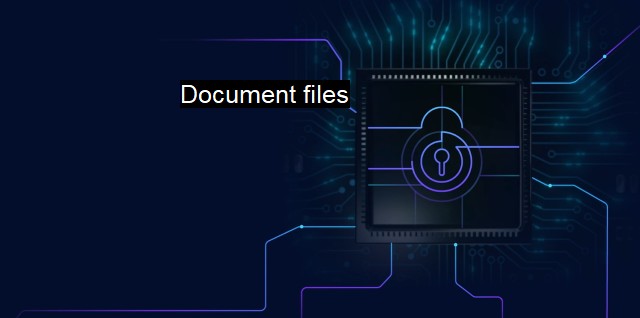What are Document files?
The Crucial Role of Document File Management in Cybersecurity and Antivirus Software
Document files refer to a category of file types, like Word documents (.doc/.docx files), Excel spreadsheets (.xls/.xlsx files), and PowerPoint presentations (.ppt/.pptx files), which play a vast role in our digital activities. They are integral aspects of modern business, education systems, and daily activities. Document files bind a large chunk of data together. These files can include text, graphs, images, hyperlinks, and more advanced forms of electronic data. There's a wide variety of applications responsible for creating and interacting with different types of document files.In terms of cybersecurity, document files carry a lot of significance. They often hold sensitive and important data, liable to be targeted by potential attackers. One of the primary risks includes viruses, malware, and other potential threats hiding inside these document files, masked as harmless content. Given that these files are commonly shared and easily accessible, they are a favored method of attack by cybercriminals who leverage weaknesses in their security mechanics or the lack of knowledge and awareness of users.
Antiviruses present a direct solution to safeguard these document files. They are software authenticators, created to ward off any suspicious behavior in a system, including document files. An antivirus scans file content for malicious signatures; these include predefined patterns of code that are known to be part of potential threats. When they detect such a signature, the antivirus will block the file from opening and alert the user to the potential risk.
In the realm of document files and antiviruses, one cannot underestimate phishing attacks. Once a user downloads or opens an infected document, malware can get installed unknowingly. Often, these documents are sent through emails appearing safe, a tactic known as phishing. This malware carryout tasks that range from harmless pranks to dire consequences involving stealing sensitive information or locking users from accessing their systems.
Another aspect often unnoticed is 'macros'. These are pieces of programming code embedded in document files to automate certain tasks. While they can be helpful, a macro can turn harmful if programmed maliciously, subsequently infecting the computer it's running on. Many viruses use macros within document files for their attacks. Ransomware, a type of malware, is notoriously known to get delivered via Office macros, making it a high-priority target for antiviruses to combat.
For effective prevention, it's essential to pair technology with user education. Combo solutions are needed, with both updated antivirus programs and vigilance from users while interacting with document files. It's crucial that users are educated about cybersecurity threats tied to document files, and steps need to be taken to secure these files both in transit and storage.
Data handlers should also be aware that while antivirus programs provide a sound line of defense against cybersecurity threats, they are not infallible. Newer forms of sophisticated, unknown viruses termed as 'zero-day threats', are not immediately recognized by antivirus programs. To protect against these, continuous updates and patches of the antivirus software become necessary.
To sum up document files hold significant importance. Safeguarding them from threats depends on a combination of technological solutions such as potent antivirus systems and human alertness and understanding of online threats posed by these files. By ensuring strong security practices, diligence about what types of document files are opened and from what sources, comprehensive antivirus protections, and regular updates, individuals and organizations can maintain a strong defense line against cybersecurity threats.

Document files FAQs
What are document files?
Document files are digital files that contain text, images, or other types of data and are used to store and share information. Common document file types include .doc, .pdf, .txt, .ppt, and .xls.Can document files be infected with viruses or malware?
Yes, document files can be infected with viruses or malware. Attackers can exploit vulnerabilities in popular document file formats and use them as an entry point to infect a system.How can I protect my computer from document file-based attacks?
To protect your computer from document file-based attacks, you should use antivirus software that can detect and block malicious documents. You should also avoid opening or downloading suspicious documents, especially if they are from unknown senders or contain unexpected file extensions.What should I do if I think a document file on my computer is infected?
If you suspect that a document file on your computer is infected with a virus or malware, you should immediately run a scan using your antivirus software. If the file is confirmed to be infected, you should delete it from your system to prevent the infection from spreading.| | A | | | B | | | C | | | D | | | E | | | F | | | G | | | H | | | I | | | J | | | K | | | L | | | M | |
| | N | | | O | | | P | | | Q | | | R | | | S | | | T | | | U | | | V | | | W | | | X | | | Y | | | Z | |
| | 1 | | | 2 | | | 3 | | | 4 | | | 7 | | | 8 | | |||||||